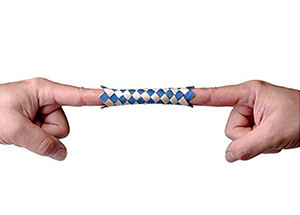How Collaboration is Like a Chinese Finger Trap
By Dr. Francis Eberle
Imagine you’ve just settled into your office for the morning, coffee in hand, desktop firing up, when two employees blow through the door. Each has a strong, yet opposing, viewpoint about the next steps for a project. And before you know it, you are drawn into playing referee or decision-maker.
This scenario is much like the Chinese finger trap. You are probably familiar with this child’s toy. You put your finger in one end and a friend puts their finger in the other end. The goal for both players is to get their fingers out. As each tries to pull their fingers out, the trap tightens—the more you pull, the tighter the trap gets, increasing the pressure on your finger.
Many leaders are familiar with this type of tug-of-war of ideas. Two people have conflicting stances and instead of trying to work through to a solution, each advocates for their own opinion and a conflict begins, making it the leader’s problem to solve. The way to resolve this is similar to how you solve the Chinese finger trap: Both people must stop pulling and instead push toward each other. This reduces the tension and opens things up.
If you apply this technique at work when you have people with opposing viewpoints, you can instead get cooperation and even collaboration. To achieve this, you can:
- Have the two people set aside their positions for the moment and work to better understand the other person’s viewpoint.
- “Go up a level” and have the two people seek agreement on the larger goal or reason for the project. Then evaluate each idea for how it will get to the goal and whether there might be other possibilities.
- Brainstorm additional ideas and evaluate them against the first two.
- Have one person, the other person or both people move their idea toward the other’s viewpoint and perhaps obtain an agreeable solution.
With an open mindset, new ideas and solutions are more readily generated. Setting aside your idea and asking how to meet the needs of both parties without discarding the other completely can help you see new opportunities.
There can be personal hurdles to this type of decision making and collaboration. These are preconceived ideas, beliefs, or emotions that can lock people into their thinking. Beliefs such as “I need to win to show how smart I am,” “It will advance my career if I have the right answer,” or “I am angry at this other person and having the right answer will get back at them,” are never conducive. These examples represent self-speak, which can take you off track and are focused on self rather than the team, company, or larger outcome. When confronted with complex problems with multiple dimensions, it takes cooperation to solve them—a give and take of ideas.
Working with other people in a collaborative fashion is full of possibility. New energy and new ideas are generated among people who are focused on solving a common problem together. But in order to achieve this, leaders must begin to address and use collaboration to help bring teams together and find purpose.
Collaboration is hard to do. There are many reasons for this: people may have personal agendas, collaboration is not generally structurally encouraged in the workplace, everyone thinks differently so consensus is sometimes not quick or even accomplishable, incentives are often individually based, and our culture reveres individuality. Some people think collaboration is for those who can’t accomplish tasks alone, that it takes too long, that it is anticompetitive or a soft skill.
Barry Osher, President of Power + Systems, Inc., says that when multiple people work together they are able to “see others, get who they are and what is important to them, and [this] helps them move ahead in their worlds.” The subtlety of collaborative leadership and its lack of a singular locus of control can make collaborations challenging in the context of traditional, directive leadership.
The challenge for all leaders to find ways to engage and honor ideas while widening perspectives to produce more good ideas. In the context of the Chinese finger trap, collaboration opens up new ideas and possibilities for everyone to win.
Dr. Francis Eberle is an advisor, author, and coach to quiet leaders. His forthcoming book, Attention!, is set to be released in early 2021. You can reach Francis at francis@price-associates.com.


